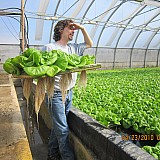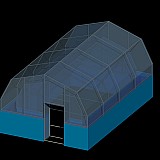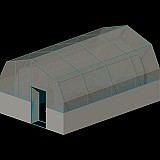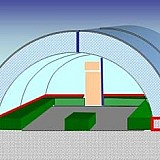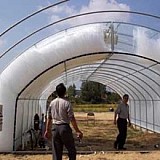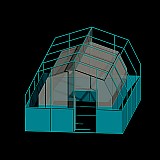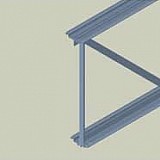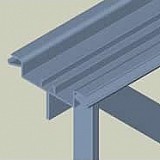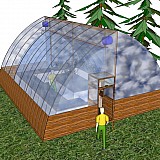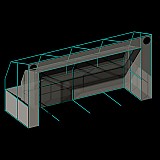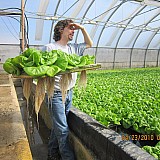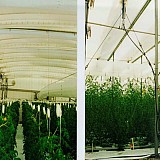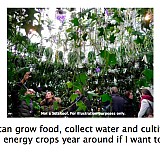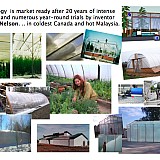Tunnel Greenhouse
DIY Food is the focus for the Sola Roof Community to develop - with the help of our Pioneers, past, present and future - the solutions that most people will use for most "grow your own food" projects, which are generally called the Tunnel Greenhouse. Our approach will enable the DI Yers to construct reliable and effective Sola Roof greenhouses using self-build techniques so that all people can access and make FREE use of these DIY solutions. View, download or print: a Google Docs presentation about DIYFood
Click an image to browse through bigger images
Thank you Nigel for providing images - Usa2k
Thanks, Jim that looks really good on the webpage. Nigel, thanks for the new set of drawings which show the equal-lateral form/geometry of these arches which produce a greater height at the peak than the typical Hoop Tunnel? (called also a barrel arch) or the Nordic Tunnel?, which is more peaked at the top ridge for purpose of shedding snow. At this scale (backyard projects we can use a constant space of 0.5 M to the inner frame form the Bubble Cavity - Sola Roof Guy
I have been thinking about how a larger scale use of this same equilateral tunnel geometry can result in a Family Farm scale greenhouse that is quite high to the peak comparative to typical tunnel structures. I am calling this the Vertical Greenhouse or "VG" - follow the link to learn more about how the VG will deliver maximum benefits and output from the smallest footprint in both Nordic Climates? and Tropical Climates by a special orientation to the sun and protocol for using Liquid Bubble Insulation.
The information provided here, at our community Wiki is intended to guide and empower our members to build at a low-cost our low-energy solar greenhouse for maximum productivity and benefits in all seasons. All information from members projects is appreciated and our experience must be shared so that the best practices can be identified as a pattern that most DI Yers will be able to use and will satisfy general purposes. This will help our solutions to be replicated rapidly and allow Sola Roof to benefit the greatest numbers of people around the world.
The Tunnel Greenhouse is a method that is most accessible and easy to construct. With your help I will begin to focus the Sola Roof Tech section of this Wiki on the subject of the DIY Kit for Tunnel Greenhouse self-build. Some of our past pioneering DIY tunnels and schematic drawings are presented in this DIY Tunnel Google Doc for viewing, downloading or printing. - Sola Roof Guy
Hobby Farm Experimental Greenhouse
I am interested in discussing the construction an operation of a "hobby farm" type of stand-alone tunnel solar greenhouse using the working greenhouse of Ross Elliott as a starting point. This would become a retirement project for me and would be an experimental project rather than a commercial project. Ideally, I would like the greenhouse to be relatively self-sustaining from an energy standpoint using small photovoltaic and small wind systems.
The goal would be to use the greenhouse for a self-contained aquaponics system (along the lines of systems developed and sold by Backyard Aquaponics of Perth Australia---(see http:/www.backyardaquaponics.com/designs.htm ) using the yellow perch species as the fish of choice (since it is high quality, much in demand at high prices and can handle much lower temperatures during the Winter) ---see http:/www.ftai.com/articles/GAAManciDec00.pdf
The greenhouse size I envision would use something like the 16' x 32' Solarstar Sidewall greenhouse kit(see www.gothicarchgreenhouses.com/solarstar.htm )as a base unit. The solaroof aspects would be added to this following the design used by Ross Elliott with input from Richard Nelson. Perhaps the design used by Ross could be improved based on his experience.
While I have read most of the material available from links on the Solaroof website, a number of issues concern me at this point: 1. The need for multiple mechancial devices (multiple water pumps, bubble generators) all of which are subject to temporary failure which would serious compromise the success of the green house if temporarily disrupted. This in turn implies that even a small greenhouse needs constant monitoring in cold weather even with automated process control devices in place.
2. The need for a large subterranean water storage tank for heat storage and side storage tanks to store the bubble solution. Assuming these were made of concrete from an excavated area, this could add considerably to the capital cost. Would buried poly tanks be a viable alternative?
3. The high cost of the bubble generators $8,000 for 2. Is 2 really enough? What if one fails on a cold winter night?
4. High humidity problems in Winter----how is this dealt with when the greenhouse is more or less sealed on cold Winter nights? Could provision be made for bringing in a constant supply of fresh 'earth tempered" air? See www.thenaturalhome.com/earthtube.htm for a discussion of this aspect.
5. Why has this technology not taken off? It appears so promising on paper. Is it too subject to mechanical failure? Several commercial ventures in the late 90's and early 2,000's in Alberta and Quebec have seem to come to naught. Why? What are the problems?
My sense is that the current high cost of energy is not going to go away but intensify. Therefore, this technology will become more and more viable with time if the bugs can be worked out.
I'm not sure I am allowed to post here, forgive me and let me know if I am out of line.
I am interested in the same thing as you, and hope to learn how to do it here. Are there any detailed plans available? How about feedback from those who have been there done that? Signed by Ohio Gardener

